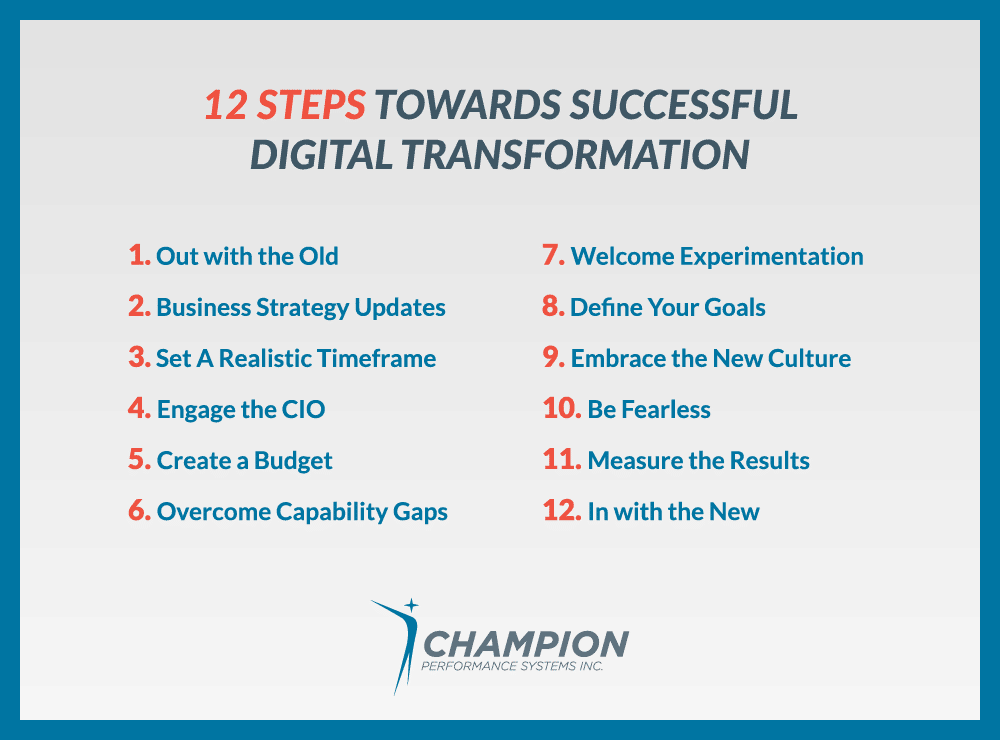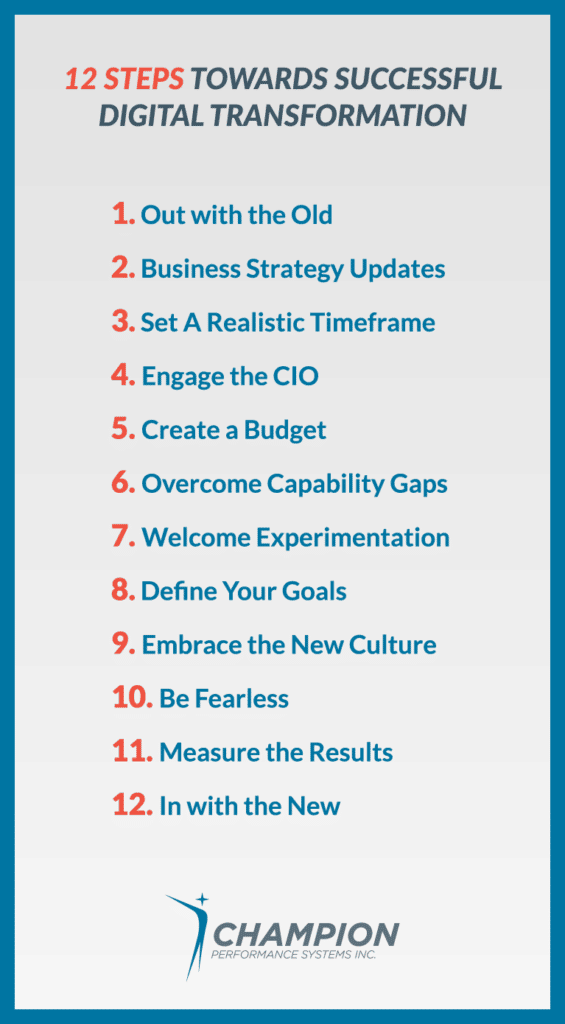Just a few decades ago, business leaders struggled with the idea of getting rid of typewriters and mimeograph machines. Today, a new phase of digital transformation is decidedly more sophisticated and complicated — leading many CEOs to seek out the help of a business coach.
Digital transformation is much more than simply “moving to the cloud.” Company executives who are ready to launch their businesses to the next level have discovered that the process is just that: a process. It takes time and planning. It also often requires a substantial shift in company culture.
Integrating advanced technology into day-to-day operations demands a strategy that must work within the long-term goals of a business plan. It likely requires investments in new programs, equipment, and software, as well as action steps that help rid your company of legacy tech that no longer meets your needs.
If the goal is creating an infrastructure that allows for a business advantage within any industry, C-level executives must think in the long term and big picture. That’s why a business coach can be so valuable – they provide practical insights you may be too close to your business to see. Connect with a digital transformation coach if you’re ready to begin right away.
Unlike the good old days when it was just a matter of buying pre-packaged software and upgrading a few computers, the modern concept of digital transformation is unique to each organization. What works for one company, even if it’s a competitor, may not work for another. CEOs will require more than an IT professional ready with a few plug-and-play changes or random technology experiments.
The process is innovative, systematic, and comprehensive. It starts at the top of an organization and can only grow from within.
With the help of a business coach, executives can better prepare their team for the work it takes to adapt to the substantial changes that come from their transformational process. When you create a plan that can be implemented in a strategic and effective way, your company will evolve to meet the ever-changing market before any crises arise.
Through the COVID-19 pandemic, many companies discovered too late that they had not created a culture that thrived in the face of challenges. Now, business leaders know they must develop systems that include remote work and new expectations of their customers. For example, cashless systems and remote sales are the norms in many industries. These developments require digital solutions.
It’s easy to feel overwhelmed with where to start, especially for leaders who fear failure and struggle with changes to the status quo. After all, technology by definition involves constant change with new concepts like the Internet of Things, Artificial Intelligence, virtual reality, and 5G streaming services.
A business coach who specializes in digital transformation can help identify where preparation and strategy are lacking. By focusing on clear communication and measurable objectives, you’ll be more likely to reach your goals while planning for the future.
What Is Digital Transformation?

Digital transformation is a company-wide cultural shift that adopts new technological processes designed to fundamentally improve the customer experience and enhance employee productivity. This concept involves increased efficiency through innovative process updates within every department and role in an organization.
This is not a one-size-fits-all upgrade. Instead, a successful digital transformation strategy will identify the weaknesses, problems, or concerns within an individual company and implement technology-based solutions to enhance its value. It’s difficult to know what is needed without first analyzing the business from a big-picture perspective.
That’s why digital transformation always requires the creation of measurable goals. These goals may include:
- Improving the customer experience
- Enhancing your company’s agility to meet new market demands
- Evolved company culture and leadership skills
- Empowering employees with technology
- Automating systems for efficiency
- Integrating digital technology in every area of the business
Don’t make the mistake of presuming that digital transformation is a process rooted in machines, machine learning, and software services. While technology is vital to the work, in the end, this is about people: your customers, your employees, and your leadership team.
Digital transformation services may include new workgroups, new job titles, and dramatic shifts in workplace culture. Some employees may fear their jobs are at risk and resist any effort to implement changes.
If leaders lack the soft skills required to get the team on board, they’ll risk failure not only of the technological upgrades but of their entire company. This is another reason why so many CEOs work with a digital transformation consulting team when embarking on such a significant project.
What To Expect from the Process
CEOs who presume the work of digital transformation can be pushed off to the CIO may be surprised. The reality is that this effort will involve all the skills and training it takes to be a good leader. And if you’re not sure whether you are doing everything it takes to maximize your abilities as a C-level executive, that’s yet another reason why it’s wise to work with a business coach.
Phase 1: Consideration
If you’re just considering a digital transformation, this is the first phase of change for your company. This is when the organization has been the same for a while, and you may not have even thought of ways to improve. Often, this is known as survival mode, where it’s just business as usual — even though you may be missing out on big opportunities to grow.
Phase 2: Education
The next phase of digital transformation is when you notice that the market has shifted. While you haven’t implemented any changes, you have started to think about it and develop ideas, as you are doing by reading this article. You may be asking more questions about the best ways to improve your business, but you have yet to initiate the transformation.
Phase 3: Strategy & Implementation
The next step is formally beginning the process. You may hire a business coach at this step to help you along the way. As you craft a plan to execute, you’ll achieve the next phase of digital transformation, which is the strategy. This can include:
- Aligning your business operations with new digital opportunities
- Offering training and new roles to improve digital competency
- Becoming more agile in your innovation
- Enhancing your digital marketing strategies
Phase 4: Innovation & Adaptation
Once you have accomplished the tough part of implementing the strategy, the work is not complete. Digital transformation includes a final step of constant innovation and adaptation.
You must commit to new trends, such as remote work, AI automation, or secure cloud-based systems. You will need to create procedures that allow for data and digital transformation analysis and an improved customer experience.
Reasons for Digital Transformation
Without a doubt, this process takes time, effort, and additional resources. Some busy CEOs may wonder why it’s worth it. Here are some reasons why every business could benefit from digital transformation:
- A workflow that is streamlined and efficient
- Data collection and monitoring for enhanced productivity
- Better customer experience
- Trained and motivated employees and leadership team
- Recognition of labor shortages
- Seamless adoption of necessary technology
- Reduction in costs with legacy systems
- Increased profits and growth potential
- Newly discovered revenue opportunities
- Agility to proactively address changes in the marketplace
Most of all, a successful digital transformation project helps businesses get to the next level — however that looks for an individual organization. C-suite executives, especially when they work with a seasoned expert in the process, can learn how to truly work smarter.
Prepare with the 12 Necessary Steps
Every business embarks on digital transformation in its own way, but some actions are universal. Here are 12 steps you can take to prepare yourself and your organization for this dramatic and worthwhile process.


1. Let Go of the “Old Way” of Doing Things
There is a critical shift in thinking that’s necessary when you’re embarking on a digital transformation within a professional organization. Before you do anything else, change your mindset toward a growth mentality and encourage others to do the same.
This is easier said than done for many. People who tend to see value in the “way we’ve always done things” or those who aren’t naturally innovative tend to play by the book. When the rules in the book change, you can get pushback. Lone wolf types aren’t always good with change that isn’t self-directed as well.
Consider your audience as you begin to craft your messaging around digital transformation. You may need to reassure your team that they won’t be left behind. This is even more important for your C-level executives, as a positive attitude starts at the top.
2. Update Your Business Strategy
In order to be successful, this process must be part of a fundamental shift in the way you do business. Revisit your business plan to identify any potential obstacles you may encounter along the way. Look at the values that make up the heart of your business to determine how you can integrate that foundation into this new initiative.
You’ll need to demonstrate why any future changes are necessary and desirable, and that won’t happen if your motivation is based on fear of competition. If you’re not clear as to the values and goals of your business already, now is a good time to work with a business coach to solidify your foundation.
3. Be Realistic with Your Timeframe
A common mistake CEOs make with digital transformation is the presumption that everything can happen overnight. This work requires major shifts in the way you and your team do business, and you must be sensitive to this. Well-planned projects, no matter how big they are, should never feel rushed or approached with a crisis mentality.
What’s more, new technology and systems will inevitably disrupt the current way of doing business. That may result in frustrations from your team, and it’s better to plan and alert than respond and apologize. Take the time to implement changes thoughtfully and in the most logical way while still running your business.
4. Engage the CIO
The leader of information technology for your organization may have been the one to bring this concept of digital transformation to your attention. But this isn’t solely an IT project. Don’t make the mistake of having them work in a silo.
Decades ago, the IT department was mostly tasked with cost savings — they kept the systems running to avoid replacements or disruptions in workflow. But modern IT departments can be a driver for innovation. Your CIO can play a valuable role in the digital transformation process, but they need your support, working together from the start.
5. Create a Budget
Chances are, you’ll need to implement new software or equipment as part of this initiative. This may demand an investment upfront, and it’s best to plan for it rather than be surprised later. Think of this as a big-picture, foundational change rather than a small project.
By planning out the work step-by-step, you will have a realistic concept of costs that will likely include training and even failures. That’s right — you may discover that some ideas aren’t effective. Get used to the idea of failure as you experiment with what will work for your business to thrive for years to come.
6. Overcome Capability Gaps
Many, if not most, people in your organization will be uncomfortable with new ways of integrating technology into the operations of your business. It’s your responsibility as a leader to help them overcome the gaps rather than demand they figure it out on their own.
Start this step with a healthy dose of empathy. It is crucial that C-suite executives build a level of trust with the team through direct and transparent communication. If an employee does not have adequate skills, let them know that you want to help them excel. When you ease their fears, you’ll gain the support of your workforce while improving their motivation.
7. Welcome Experimentation
What does digital transformation mean for your company and your industry? Now is the time to go to the drawing board with your team. Define which digital moves make sense for your business. This may mean going paperless, integrating AI, formalizing a flexible work format, or implementing new data analytics.
The more open you are to creativity, the more likely your team will surprise you with great ideas. After all, customer-facing employees may hear concerns that C-level executives do not. Welcome all ideas and consider them fully with a yes before no mentality.
8. Define Your Goals
In order to determine your return on investment, you must have a specified method of measurement. You need to define goals before moving beyond vision to execution.
Before launching into the digital transformation changes, create metrics you can track. Know the baseline for both your long-term and short-term goals. The smaller the measurement tools, the easier it will be to stay agile and learn from the process.
9. Embrace the New Culture
If you’ve started your company, you may be more stubborn than you realize in terms of change. But you can’t expect your team to be flexible and open to a new methodology if you aren’t. The entire executive team must be welcoming of a new culture moving forward.
To start, you must engage your employees. If this looks and feels like a top-down mandate, you’ll encounter resistance that will limit your success. If instead, you work directly with your team on all levels, they’ll want to help your company grow and succeed. After all, your success should be their success.
10. Be Fearless
Sometimes, the motivation behind digital transformations is the acknowledgment that your competition is doing something different and creating a business advantage. Other times, you may be the one in front. All executives know which position they prefer.
When you integrate new and emerging technology without fear, you will approach change with a positive mentality, and try new ideas ahead of the competition. You’ll be more comfortable cleaning up redundant systems, integrating new systems like chatbots, or implementing different marketing strategies. In short, you will take more risks — increasing your ROI when the efforts work.
11. Measure Your Results
It’s one thing to create measurable goals, but scheduling and executing the actual measurements is a larger undertaking. Don’t make the mistake of launching a big company-wide initiative without circling back to see what worked and what didn’t. Make a strong plan to evaluate the strategic impact in relation to your business model.
This may mean comparing revenue growth from previous quarters and requesting data through surveys and other feedback tools to determine customer value. If your business is based on manufacturing specific products, you may be able to track the time to market. Your operations leaders may be able to identify scalability factors, improved efficiencies, and impact to cost.
12. Get Used To Change—In with the “New”
If you find the efforts associated with your digital transformation aren’t working, don’t declare defeat. Instead, use all feedback as opportunities to continually pivot your business strategy to adjust to the inevitable changes in the marketplace.
When you, your leadership team, and your employees are all adaptive, you’ll find that the entire organization is properly positioned for any surprises in the future. You never know when the next pandemic or other significant market shift will occur, but this transformation will ensure that you’re ready.
How a Business Coach Can Help with Digital Transformation
No smart CEO would attempt such an undertaking without first consulting professionals. While your IT leaders can provide crucial help, the best support system for digital transformation is with a third-party, independent professional.
A business coach can offer great value during this important time, as they can make success more likely through wisdom gained by previous experience and targeted training. With a business coach specializing in digital transformation, you can expect:
Objective Yet Seasoned Advice
Business leaders should always be evolving to meet the needs of their target audience, but too many pivots at once can be overwhelming and disastrous. Leaders benefit from seasoned advice when making decisions that will impact the future of the company. A knowledgeable consultant is especially valuable in light of the opportunities (and disruptions) that come from digital advances.
Support with Big Moves
Transformation demands changes that can feel like moving mountains, and digital trailblazers must have a clear vision and a strong method for execution in order to succeed. Your company will thrive during times of change if you receive guidance from someone with a strong track record.
Help Improve Company Culture
Positive, agile, and thriving employees develop through the leadership of the executive team. Business coaches can support executives as they become even more resilient, flexible, and proactive to changes in the marketplace.
You can learn how to lead by fostering a creative and supportive environment rather than by top-down mandates that are less effective. When you deepen your communication skills, you hear new ideas to improve outcomes and overcome obstacles on the path to meeting business goals.
Leveraged Wisdom and Training
When you are looking at a map, there’s value in having a bird’s eye view — and that’s what a digital transformation expert can provide. They’ll assist leadership teams with an in-depth understanding of emerging infrastructure, trends, and data while helping to create and implement an action-oriented, technical strategy.
Business coaches work with you, so you stay in control of the transformation of your company. You can measure improved safety mechanisms, a smoother deployment of the plan, and better results than if you underwent the process without assistance.
Work with Champion Performance Systems Inc.
It’s a more complex world than when top executives brought in copying machines and laptop computers. Today’s technology is constantly changing, and so are the expectations of customers. Regardless of the industry, executives are discovering the business advantage that comes from working with a business coach to transform their operations with technology.If you’re ready to embark on a digital transformation of your company, connect with Champion PSI. Our business coaches are trained specifically for this process, as well as scaling business through leadership, team, and executive support. For services that can be in-person or remote, contact the Champion PSI digital transformation team today.










